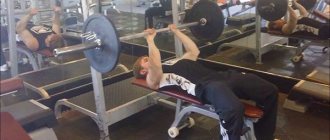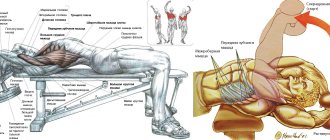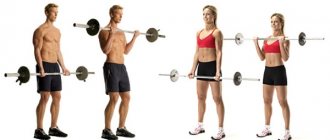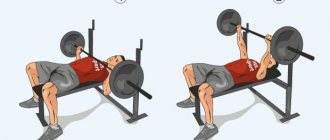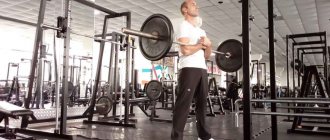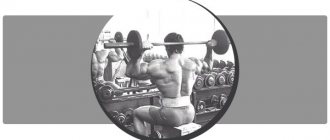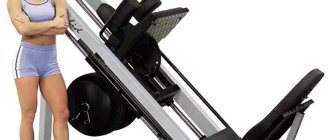Share:
The dumbbell push press is a multi-joint basic exercise aimed at developing explosive strength in the muscles of the shoulder girdle and legs. This movement is universal, therefore it is used in many sports: from athletics to powerlifting. The dumbbell push-up is considered a more technically challenging exercise than the barbell push-up, as it requires more effort to hold and stabilize the dumbbells in your hands.
This dumbbell exercise will allow your muscles to prepare for a technically more complex and complex exercise - dumbbell thrusters.
What muscles are used by barbell pushups?
The main muscles when performing shvungs will be:
- Deltoid.
Namely, their front and middle bundles. Due to their reduction, the bar is pressurized. - Triceps.
Responsible for extension of the arm at the elbow joint. They work with deltas in tandem. - Quadriceps.
Responsible for straightening the legs at the knee joint. It is this movement that allows you to create the initial impulse for the movement of the barbell. - Gluteal muscles.
Extend the leg at the hip joint. Together with the quadriceps, they create an inertial wave to throw the barbell upward. Also responsible for stabilizing the pelvis. - Calf.
When working with heavy weights, most athletes go into a toe stand. This allows you to create additional acceleration. The calf muscles are responsible for straightening the feet.
In addition to the main muscles, a large number of auxiliary muscles are involved in performing shvungs. These include:
- Breasts.
Their upper (clavicular part). They help to press the barbell up. But since we stand vertically, their role in this movement is not so significant. - Trapezius, serratus anterior and rhomboids.
Responsible for stabilizing the shoulder blades. - Spinal extensors and abdominal muscles.
Responsible for stabilizing the spine. - Muscles of the back of the thigh.
They are actively switched on when the bar is returning to its original position and in push strokes. Responsible for stabilizing the femur.
Execution options
- You can do a barbell push from behind your head ; this option is good for those people who have sufficient flexibility in the shoulder joint. In bodybuilding, it is generally accepted that such a shvung works more on the middle deltoid bundles. In weightlifting, movement is used to teach balance with weight;
- Push shwung . It differs in that there is no phase of pressing the projectile with hands; as soon as the bar reaches eye level, the athlete goes under the bar and pushes the weight upside down. This option is the most technically complex in fitness; bodybuilding and crossfit are almost never used
Advantages and disadvantages of shvungs
Advantages
- Helps develop the muscles of the shoulder girdle. Due to this, results in basic exercises are increased, such as: BENCH PRESS.
- In bodybuilding, pulleys are used to increase the working weight in the OVERHEAD BAR PRESS. This is true for more experienced athletes who have fallen into stagnation and cannot get out of it. After all, do not forget that it is the progression of the load that creates the necessary stress for muscle hypertrophy.
- In weightlifting, push-ups are used as an auxiliary exercise for practicing elements such as the “push” and “press.”
- Coordination of movements develops. As a result, it will be possible to begin more complex weightlifting exercises.
- Development of the muscles of the legs and buttocks. Due to this, strength results in SQUATS and LEG PRESS will increase.
- This exercise is energy-intensive, as it uses a large number of muscles. Therefore, it will fit perfectly into fat-burning workouts.
- Strengthening the shoulder, elbow, hip and knee joints. Consequently, the risk of injury when working with heavy weights will be reduced.
Flaws
- Beginners involved in bodybuilding should not start their training journey with shvungs. Since this exercise is more difficult to master than classic presses.
- Due to the use of heavy weights and lifting the barbell above your head, there is a large axial load on the spine. If the technique is incorrect, you can injure him.
The benefits and harms of exercise
The advantages of shvungs are obvious:
- The large number of muscles involved makes shvungi an energy-intensive exercise. Which is good at the stage of losing weight and when training strength endurance.
- Allows you to develop shoulder girdle strength. Heavy weight, provided the correct technique is used, will strengthen the ligamentous apparatus.
- Well, for those involved in weightlifting, shvungs will serve as an effective means of increasing athletic performance.
But there is a fly in the ointment:
- Shvungs, like other exercises with axial load, are not recommended for people with spinal diseases. But the main load goes to the shoulder joint, so if it is injured or diseased, movement should definitely be excluded.
- The exercise technique is not easy to master and requires considerable effort, and even better, a good mentor.
Press press
This version of shvungs is the most common. When performing it, most of the load falls on the front deltoids and triceps. The push press consists of three stages. Receiving the starting position, pressing and returning to the starting position. But, before you begin, you need to position the bar correctly. It should lie on the front deltoids. To do this, in the initial position you need to bring your elbows forward and raise them up. This will lead to flexion of the arm at the shoulder joint, creating a kind of platform from the front delts where the barbell can be placed. The palms tightly grip the bar and act as stabilizers, preventing the bar from swinging. Try practicing this technique with an empty bar. Don't worry if you can't raise your elbows much. However, everyone has a different degree of joint elasticity. The main thing is that in the initial position the bar does not lie on your hands.
Execution technique
Initial position:
- When performing a push press, it is best to take the barbell from the racks. To do this, you need to place it at the level of the pectoral muscles.
- We do a small squat and crawl under it.
- We bend our arms at the shoulder joints and bring our elbows forward. We place the bar on the front deltas and the clavicular part of the pectoral muscles. Place your palms slightly wider than shoulder-width apart and squeeze the bar tightly.
- The feet are at shoulder level. The gaze is directed forward.
- Next, remove the barbell from the racks by extending the legs.
- Let's take one step back. Feet stand shoulder-width apart, back completely straight, with a slight arch in the lower back. Elbows are forward, the bar rests on the front delts.
Performance:
- From the starting position, bend your knees slightly. In weightlifting lexicon this is called a “squat”. That is, we bend our legs ¼ from the vertical.
- Next, while exhaling, we quickly straighten our knees, creating an inertial wave that will throw the barbell up. As soon as the bar comes off the deltas, we connect our hands. Having straightened them at the elbows, we squeeze the barbell over our heads and lift them slightly behind our heads.
- At the end point, the bar must be strictly vertical relative to the axis of the body. Arms and legs are completely straightened.
- Now you need to return the bar to its original position. The process is reminiscent of rewinding. Bend your arms and lower the barbell down. As soon as it passes the chin, we do a squat and place the bar back on the front delts. Straighten your legs.
Recommendations for implementation
- When performing a squat, the knees should not go beyond the toes and come together. This technique will affect stability. It will also create a breaking load on the knee joints, especially when working with heavy weights. Therefore, we concentrate our attention not on bending the legs, but on abducting the pelvis. During the squat, the knees move slightly to the sides.
- In the initial position, the body is completely straight. There should be no deviation forward or backward.
- When squatting, the elbows do not fall down. This may cause the barbell to fall. Also, bending the torso and rounding the back is not allowed.
- When performing a squat, 70% of the weight falls on the heels.
- It is very important that at the end point, when the bar is at the top, your legs are on your entire foot. To do this, before fully straightening your arms, you need to lower yourself from your toes to your heel.
- When lifting the barbell upward, an obstacle in the form of a chin will be encountered in its path. To avoid hitting the vultures, move your head back and arch your back slightly. As soon as the bar passes the obstacle, we return it back and remove the deflection.
- The barbell is lifted straight up. If you push it forward while lifting, you may lose your balance and fall.
- At the top point, the bar is located in the same plane with the body. To do this, you need to pull her back a little behind her head. Thanks to this, the weight of the barbell will be systematically distributed throughout the body and will not put pressure on the shoulders.
- There should be no bending of the wrists in the upper position. To do this, it is important that the bar is not located in the area of the fingers, but closer to the middle of the palm.
Execution technique
So we got to the most important thing - the technique of swinging kettlebells with two hands. Let's look at this exercise down to its core, starting from the starting position and ending with its highest point.
Starting position
Traditionally, let's start from the starting position:
- Feet slightly wider than shoulder width.
- Toes are placed apart at 45 degrees.
- Feet pressed firmly to the floor.
- The center of gravity lies on the heels.
- The pelvis is laid back, the back is perfectly straight.
- We do not tilt our heads down and do not bend our necks back; our gaze should be directed strictly in front of us. The kettlebell stands on the floor between your legs.
Correct execution of the movement
We lift the weight off the floor and make a small swing back towards the gluteal muscles. A slight tilt of the body forward is allowed, but the back must remain straight throughout the entire movement; rounding it is unacceptable.
As the weight begins to fall by inertia, we make a powerful effort with our legs and gluteal muscles. The knee joint straightens, the pelvis moves forward. Shift the center of gravity from the heels to the middle of the foot
The movement should be powerful and fast, but not abrupt, it is important to understand the biomechanics of the movement, for this it is recommended to start performing this exercise with a light weight for a large number of repetitions
If the movement is performed correctly, the kettlebell should “fly” in front of you. Usually the inertial force is enough until the weight reaches the level of the solar plexus, then you should engage the front deltoids and bring the weight to the level of your shoulders or chin. From this position, the apparatus is lowered down to approximately knee height, placed slightly behind the heels, and another repetition is performed.
”alt=””>
Push shwung
Push pushes are not very popular among athletes. This is because this exercise consists of a large number of elements and requires careful practice of the technique. The push type of push-ups is preferred by weightlifters, as it actively loads the muscles of the legs and buttocks.
Execution technique
- The starting position will be the same as when performing push presses. The only difference is the weight of the bar. In this version it will be larger.
- Let's secure the main elements: the bar rests on the deltoids, the elbows are brought forward, the back is straight, the palms tightly grip the bar, the legs are shoulder-width apart.
- Next, we do a shallow squat by moving the pelvis back and bending the legs at the knee joints.
- As you exhale, we perform a low jump by straightening your legs. At the same time, we begin to press the barbell up and land with our full feet on the floor, legs slightly bent.
- Now we get up from the squat holding the barbell above our heads.
- After a short pause we return to the starting position. That is, we bend our arms and as soon as the barbell approaches the deltoids, we do a squat and place it on the deltoids.
To make it more clear what it all looks like, I recommend watching a video with the push shung technique:
Correct technique for performing the exercise
Your entire result depends on how unquestioningly you follow the technique of performing a bench press with a narrow grip and “catch” the contraction of the necessary muscle groups, whether it is aimed at developing strength indicators or gaining muscle mass.
Let's look at the most common option in gyms for correctly performing this exercise on a horizontal bench.
Initial position
Lie down on a bench so that the bar of the barbell is approximately at eye level. We try to bring the shoulder blades together, the back of the head and pelvis are pressed tightly to the bench, for greater control over the position of the body on the bench, statically tighten the buttocks. We press our feet firmly into the floor, it is advisable to do this with the whole foot, focusing on the heels - this way your position will be more stable, but this moment depends on the flexibility of your ankle joints. Wrap your hands tightly around the bar, using a closed grip. The grip width is slightly narrower than shoulder width. Your elbows should be slightly bent.
Straighten your elbows and lift the barbell off the rack using the force of your triceps. This moment is the most traumatic for our wrists.
Now place the barbell above your lower chest, just short of your solar plexus.
Begin to smoothly lower the barbell down until the bar touches your chest, taking a deep breath. The elbows should move as close to the body as possible, while placing them to the sides or trying to bring them inward can result in injury.
Barbell bench press
When you touch the bar to your chest, begin to press the barbell up, exhaling powerfully; pausing on the chest in the bench press with a close grip is not necessary, since here we are pursuing slightly different goals than developing the explosive strength of the pectoral muscles and shoulder girdle. At this point, you will feel a contraction of the inner chest and medial triceps. Perform one repetition, fully straightening your elbows and pausing for a second at the top point, then lower the bar to your chest again, trying to work in the same trajectory.
The technique of performing a barbell press with a narrow grip is shown in this video:
”alt=””>
If you want to increase the intensity of this exercise, try doing the bench press with a close grip, not fully straightening your elbows at the top and working without stopping in any position.
There is another variation of performing the barbell press with a narrow grip - lying on an inclined bench, however, this exercise has not gained mass popularity among gym goers due to its technical complexity. Indeed, it is quite difficult to “catch” the contraction of the muscle groups we need; with the correct technique, the load is accentuated in the middle of the upper chest, the so-called “collar”.
The main technical difference here is that you should try to place the barbell not on the lower part of the chest, but almost on the collarbone. In this case, it is not necessary to do the exercise in full amplitude (until the bar touches the chest), it is necessary to catch the point at which the section of the pectoral muscles that interests us will be stretched as much as possible, and try to stay in this position for a second or two - this way the contraction of the “collar” will be most noticeable . If you get a good feel for the biomechanics of the close grip incline press, your upper pecs will look really powerful and massive.
Recommendations for implementation
- Don't squat too deep. The main task is to achieve maximum speed when extending the legs. And it’s easier to do this from a small start.
- It is very important to learn how to maintain balance when performing a push push. To do this, you need to lift the bar strictly vertically.
- Lifting the barbell occurs not due to the efforts of the deltoid muscles and triceps, but due to the second squat.
- At the moment of jumping from the starting position, there is no need to lift your legs. Lands on your full foot, not your toes. Before you start working with weights, it is worth practicing this phase of the exercise. Since any inaccuracy can lead to serious consequences.
- The main difficulty when performing a push push occurs in the second phase of the exercise, namely at the moment of receiving the barbell with straight arms after jumping. In this position, the body will be slightly tilted forward. And in order to properly distribute the weight, you need to collect the shoulder blades. This can be achieved by pushing the chin forward.
- The core muscles should remain tense throughout the entire exercise.
Nuances
Regardless of whether the push is a press or a push, they require significant effort to perform. If we compare these seemingly similar exercises at some points, then the push, unlike the bench press, requires 30% more effort during actions.
This occurs due to the fact that each subsequent squat goes deeper and at the moment of lifting the weight. Compared to the bench press, the clean and jerk is much more suitable for rapid physical development of the body. During the push press - a squat with a quick bend of the pelvic part, a thrust associated with the rapid straightening of the pelvis, a final booster. When pushing, it requires a lot more force. The main thing is a well-pumped abs and legs (a lot has been written about their training in the article: how to pump up your legs), the correct placement of your hands.
To begin with, it is enough to lift a weight of 45 kilograms. To achieve the desired result as quickly as possible, it is advisable to do push-ups 15 times, then a break of 30 seconds, repeat the same pattern 5-6 times. Depending on the result, the load should be increased only after it is possible to do the required number of repetitions with a short break between approaches, in the absence of pauses after the push.
Worthy replacement
Exercises in CrossFit with a barbell can be replaced with kettlebells, and the result will be no worse. You can do push-pull with one or two weights. These exercises have their own rules and sequence.
Single kettlebell workout:
- Starting position: legs shoulder-width apart, feet relaxed and directed slightly to the sides, back straight.
- This is followed by a chest lift - a sharp movement using a rocking pelvis that helps lift the weight.
- Do the push in the same way as with a barbell.
When the weight is above your head, you need to straighten up completely, lower the weight to your chest and repeat.
In the case of training with two, there are nuances that significantly affect the correctness of its implementation. Subsequence:
- The starting position of the body is the same as with the exercise with one.
- Raise the weights to your chest and begin the movement by rocking your pelvis, slightly tilting your body back to catch the weight and make a swing.
- Push the weights up while going into the squat position. You need to keep your back straight and direct the weight upward, and not in an arc - otherwise, you can lose your balance and get up from a crouch.
- You need to fix the raised weights above your head with outstretched arms, while standing up from a squat.
We see that the main mistake of training with two weights may lie in their wrong direction
It is important that the back is sufficiently trained to maintain the correct position during various exercises and avoid injury.
Tips for maximum efficiency
- Before starting your workout, you should complete a set of WARM-UP EXERCISES. Particular attention should be paid to the elbow, shoulder, knee and hip joints.
- Before increasing the weight of the weight, practice the exercise technique. Beginners are advised to use an empty bar and perform shvungs under the guidance of an experienced mentor.
- Athletes with weak wrist joints should use wrist wraps.
- Shungis are designed to strengthen joints and ligaments. Therefore, it is recommended to work with heavy weights for 6-8 repetitions. Usually 3-4 approaches are performed, of which the first is a warm-up. Rest between them for 1-2 minutes.
- Shvungi requires not only joint strength, but also a certain flexibility from the athlete. Therefore, take time at the end of your workout to COOL UP.
At the end I would like to make a small summary. Squats are a great accessory exercise to help you get past weight plateaus. This is especially true for bodybuilders. If you belong to the weightlifting culture, then your training will not be complete without shvungs. Before adding them to your training program, you definitely need to work out the technique. This way you will protect yourself from injuries that you can get while doing it.
Good luck to everyone in your training!
Example workout
At home
If you are involved in CrossFit or weightlifting at an amateur level and want to do a workout at home, then having free weights is a must-have. But it doesn't have to be a barbell. You can use dumbbells or weights as weights.
Unlike a barbell, these exercises cannot be placed on the shoulders, so you need to perform them with extreme caution. When performing a movement with a dumbbell or kettlebell, your palms should be turned towards each other.
What a workout might look like:
- Shwung press with dumbbells – 3-4 sets of 6-8 reps.
- Shvung push – 3-4 sets of 6-8 repetitions.
In the first exercise, you focus on the muscles of the shoulder girdle and arms, and in the second, you load your legs and practice the squatting technique.
In the gym
Within the walls of the hall you will already have a barbell at your disposal, the news cannot but rejoice!
The training can go like this:
- Shvung with a bench press bar – 3-4 sets of 6-8 reps.
- Push push – 3-4 sets of 6-8 reps.
As you can see, the essence of the workout is the same as at home.
Analysis of the exercise
The push press is a special preparatory exercise from the weightlifting arsenal. It teaches the athlete to push the weight with straight arms. In this sport, both the technique described above and the push press, push and push from behind the head are used. Shvungs work on the upper phase of the movement, the push from the collarbones.
What muscles work
Contrary to popular belief, push-ups do not load more on the middle delta, but on the anterior and triceps, especially when it comes to the bench press version. Therefore, some American strength coaches consider the movement a suitable “auxiliary” for the classic bench press in the speed version.
Almost all muscles of the body work as “auxiliary” muscles - quadriceps and hamstrings, buttocks. Gastrocnemius and soleus. When working from the collarbone upward, the movement includes the abs, lats and trapezius. If the grip is wide enough, you can shift the emphasis to the middle delta.
Proper execution
- At the start, the forearms should be as close to the body as possible, and the elbows should be straightened so that the athlete has time to bring the body under the bar. Rotation of the elbows should be avoided;
- The arms should be fully extended when the lifter holds the barbell overhead;
- You should not stand with the projectile at the top point for too long;
- Shungs differ from presses in that they are performed by accelerating the weight with the legs, and not in the power version;
- You need to concentrate so that two-thirds of the way the bar travels by inertia, and only the push is carried out by the front deltoid and triceps;
- Footwork should be fast and explosive;
- You need to think about your legs as if you were going through the top of a barbell squat;
- When pressing from the chest, the head is pulled back so as not to interfere with the trajectory of the projectile
